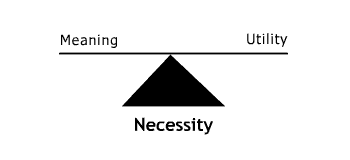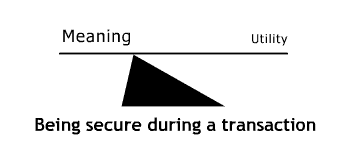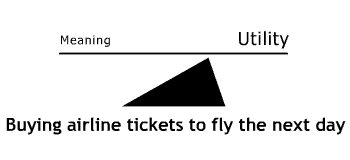The first thing to do when starting a project is defining its goals. Sometimes, the goal can be broken down in sub-goals, but one of them must prevail and, generally, this goal accounts for company needs, not customer needs. For example, the overused goal “increase customer loyalty” emerges from the company need of retaining current customers and not from some sort of customer need to establish a relationship with them. In fact, when customers really have this need, more often than not companies take their loyalty for granted and don’t invest in improvement of customer relationship.Worse than that is when customers don’t want to be loyal at all and the company invariably tries to impose on them some sort of point program. Wasted effort!
My suggestion to avoid wasting money and time, is to base project goals on customer needs. The company goal would be to fulfill those customer needs and profit thereby. This means commercial advantages wouldn’t be the goal, but rather a natural consequence.
This apparently simple change in business statements requires more company investment in customer surveys and establishing effective communication channels to precisely detect customer needs. Without such investment, these new business statements will sound as empty words. The written goals might change, but relationships can continue placing the company as number one, and customers as second.
We’re always hearing business analysts saying that the global economy is changing toward empowering customers and customers hear that too. Which means they’ll expect smart companies to follow this new paradigm. So, if a company doesn’t like to work that way, its image may appear obsolete.
Curiously, I know many people who make interactive products that are obsolete in this sense, although working with high technology. They have enough technology to establish customer-relationships, but don’t know how to develop them in useful ways. So many times I heard: “It’s cool to have high-quality service, but above all, we need to increase our profits”…
The transition to the new business paradigm won’t happen overnight. Adapting to this new reality requires revising concepts very well established in all of society. To change without understanding why we’re changing, is not true evolution.
Observation of specialized mailing-lists and websites led me to conclude that your need now, is how to put this into practice.
The Web has many articles about how to access user expectations. It’s possible to run online surveys, face-to-face interviews, search-log analysis, contextual inquiry and so many other techniques. No matter what method you use, my advice is to concentrate on finding specific needs that can be fulfilled by the solution you’re working on.
For instance, “security needs of e-commerce customers”. Many researches point out that up to now this concern is one of the biggest obstacles in ecommerce development. But this statement isn’t clear enough. What kind of security are we talking about? Real or perceived? Because we can have a truly secure system that users don’t feel safe about. Actually, systems of respectable companies are already very secure, but I think many of them don’t make users feel confident enough about them.
In reaction to the buzz around hacker attacks, software vulnerability, virus, trojans, spywares and all those things that make people read news to cope on with them, ecommerce companies developed more on real security and less in perceived security. We have here a dual scale: either you tend toward one side, or toward the other.
In order to have true security, we need to ask users to remember passwords, to upgrade their softwares, to use the mouse instead of the keyboard to input data and other security issues that, many times, doesn’t make sense to the users. If they don’t understand that it’s important to spend time on these issues, they won’t feel safer because of them and, worse, they can even become angry about them.
On the other hand, if we create an easy environment, jumping crucial security issues to save time, the system is less secure. Just as the presence of guards and good illumination inside a bank, intelligent graphic design plus familiar writing can make users feel safer too. An advertising campaign can be even more efficient to this extent. However, such efforts could divert investments from real security, causing the system to be less secure than it could be…
If one thing excludes the other, what could be done? If we look carefully, we can find the exact point of the scale where the solution can meet user requirements. The following diagram helps me think about the problem:

This is a generic balance, but if we use a specific example, we can understand its value. If we were struggling with security for a ecommerce website aimed at people that don’t feel comfortable using computers, the diagram would be as follows:

As we can see, to balance the points for this necessity (expressed by the triangle’s form), we need to put more weight at the meaning side than at the utility side. That means we would strive to get a confidence inspiring graphic design, advertising campaigns, good writing, etc. In this case, usability weight would be on the meaning side, because users will feel safer when they know that they can control the interface easily.
But in that case, usability weight would be on the utility side:

If someone needs to fly tomorrow, maybe in a hurry, the transaction should be easy and fast (utility), although the customer might like to know what ticket has best expected cost-benefit (meaning).
As every model, the necessity balance is a simplification of a complex choice that can take much more than 2 dimensions — if we are struggling with political, economic, social and cultural factors, all at the same time. Even if we imagine many balances at once, the model won’t encompass intrinsical relationships between them. That means it cannot be used in a practical manner, such as included in a methodology. In other words: the necessity balance has more weight on the meaning side than on the utility side.